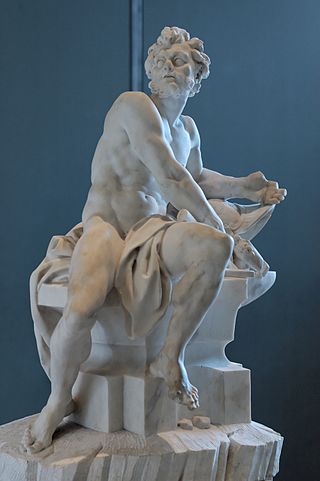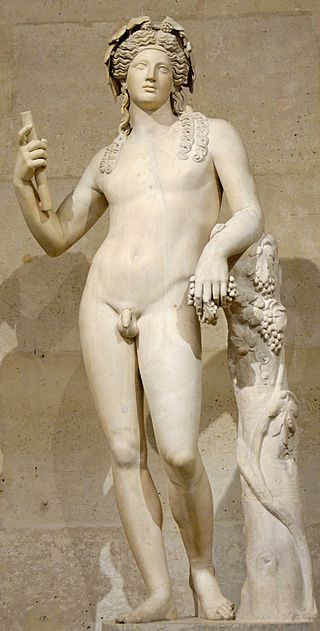
In ancient Greek religion, Hera is the goddess of marriage, women, and family, and the protector of women during childbirth. In Greek mythology, she is queen of the twelve Olympians and Mount Olympus, sister and wife of Zeus, and daughter of the Titans Cronus and Rhea. One of her defining characteristics in myth is her jealous and vengeful nature in dealing with any who offended her, especially Zeus's numerous adulterous lovers and illegitimate offspring.

Hephaestus is the Greek god of artisans, blacksmiths, carpenters, craftsmen, fire, metallurgy, metalworking, sculpture and volcanoes. Hephaestus's Roman counterpart is Vulcan. In Greek mythology, Hephaestus was either the son of Zeus and Hera or he was Hera's parthenogenous child. He was cast off Mount Olympus by his mother Hera because of his lameness, the result of a congenital impairment; or in another account, by Zeus for protecting Hera from his advances.

In ancient Greek religion and myth, Dionysus is the god of wine-making, orchards and fruit, vegetation, fertility, festivity, insanity, ritual madness, religious ecstasy, and theatre. He was also known as Bacchus by the Greeks for a frenzy he is said to induce called baccheia. As Dionysus Eleutherius, his wine, music, and ecstatic dance free his followers from self-conscious fear and care, and subvert the oppressive restraints of the powerful. His thyrsus, a fennel-stem sceptre, sometimes wound with ivy and dripping with honey, is both a beneficent wand and a weapon used to destroy those who oppose his cult and the freedoms he represents. Those who partake of his mysteries are believed to become possessed and empowered by the god himself.

Semele, or Thyone in Greek mythology, was the youngest daughter of Cadmus and Harmonia, and the mother of Dionysus by Zeus in one of his many origin myths.
In Greek mythology, Apate is the goddess and personification of deceit. Her mother is Nyx, the personification of the night. In Roman mythology her equivalent is Fraus (Fraud), while her male counterpart is Dolus (Deception), and her opposite number Aletheia, the goddess of truth.
In Greek mythology, Deimos is the personification of fear. He is the son of Ares and Aphrodite, and the brother of Phobos. Deimos served to represent the feelings of dread and terror that befell those before a battle, while Phobos personified feelings of fear and panic in the midst of battle.

Phobos is the god and personification of fear and panic in Greek mythology. Phobos was the son of Ares and Aphrodite, and the brother of Deimos. He does not have a major role in mythology outside of being his father's attendant.

In Greek mythology, the Horae, Horai or Hours were the goddesses of the seasons and the natural portions of time.

In Greek mythology, Peitho is the personification of persuasion. She is typically presented as an important companion of Aphrodite. Her opposite is Bia, the personification of force. As a personification, she was sometimes imagined as a goddess and sometimes an abstract power with her name used both as a common and proper noun. There is evidence that Peitho was referred to as a goddess before she was referred to as an abstract concept, which is rare for a personification. Peitho represents both sexual and political persuasion. She is associated with the art of rhetoric.

In ancient Greek religion and mythology, Iris is a daughter of the gods Thaumas and Electra, the personification of the rainbow and messenger of the gods, a servant to the Olympians and especially Queen Hera.

In ancient Greek religion and myth, Nemesis also called Rhamnousia, was the goddess who personified retribution for the sin of hubris; arrogance before the gods.

The Dionysiaca is an ancient Greek epic poem and the principal work of Nonnus. It is an epic in 48 books, the longest surviving poem from Greco-Roman antiquity at 20,426 lines, composed in Homeric dialect and dactylic hexameters, the main subject of which is the life of Dionysus, his expedition to India, and his triumphant return to the west.

In Ancient Greek religion and mythology, the Erotes are a collective of winged gods associated with love and sexual intercourse. They are part of Aphrodite's retinue. Erotes is the plural of Eros, who as a singular deity has a more complex mythology.
In Greek mythology, Nicaea or Nikaia is a Naiad nymph of the springs or fountain of the ancient Greek colony of Nicaea in Bithynia or else the goddess of the adjacent lake Ascanius. She is the daughter of the river-god Sangarius and the mother-goddess Cybele. By the god of wine, Dionysus, she mothered Telete (consecration) and Satyrus, as well as other children.

In Greek and Roman mythology, Aura is a minor wind goddess, whose name means "breeze". The plural form, Aurae is sometimes found to describe a group of breeze nymphs. According to the late antiquity writer Nonnus, Aura is the daughter of the Titan Lelantos and the mother, by Dionysus, of Iacchus, a minor deity connected with the Eleusinian mysteries, while Quintus Smyrnaeus makes the Aurae daughters of Boreas, the god of the north wind. Aurae was the title of a play by the Athenian comic poet Metagenes, who was contemporary with Aristophanes, Phrynichus, and Plato.
Lelantos or Lelantus is a minor mythological figure that appears in the late epic Dionysiaca by Nonnus of Panopolis, written in the early fifth century AD.
In Greek mythology, the name Oenoe or Oinoe may refer to:

In Greek mythology, Asteria or Asterie is a daughter of the Titans Coeus (Polus) and Phoebe and the sister of Leto. According to Hesiod, by the Titan Perses she had a single child, a daughter named Hecate, the goddess of witchcraft. Other authors made Asteria the mother of the fourth Heracles and Hecate by Zeus.
In Greek mythology, Beroe may refer to the following divinities and women:
In Greek mythology, Cissus or Kissos was a satyr who was turned into an ivy plant. His story survives only in Nonnus's early fifth century AD epic poem Dionysiaca.













